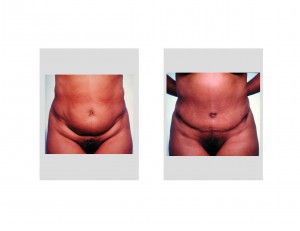While tummy tucks have always been used to recontour the post-pregnancy body, they have grown in popularity over the past decade due to increased use of weight loss methods. (e.g., bariatric surgery) While it is major body surgery, it is tremendously effective at removing loose skin and fat from the abdomen and major complications with it are actually fairly rare. By far the most common complication is that of a seroma or fluid build-up after surgery. That is why drains are placed and used after surgery as a prevention method.
The occurrence of seromas after tummy tucks is very common. Even though drains are used for a week or two after surgery, they can still occur. I usually counsel my Indianapolis tummy tuck patients that up to 30% of patients will develop seromas two to three weeks after surgery despite the use of drains. The larger the tummy tuck and the greater amount of skin and fat removed, the more likely one will develop it. While drains are helpful, they definitely are not completely preventative of seromas.
While most seromas are treated non-surgically by needle aspiration, they pose a nuisance for patients. Most seromas will require multiple needle aspirations (taps) spaced a week apart for up to a month after drain removal. This causes an inconvenience for patients and some intermittent mild discomfort as the fluid accumulates.

In the October 2011 issue of Plastic and Reconstructive Surgery, a clinical study was reported that employed both of these intraoperative maneuvers to decrease seroma formation after tummy tuck surgery. The authors approach was to use a longer tummy tuck incision, limited undermining of the upper abdominal skin flap to just the tunnel needed for rectus fascial plication with liposuction undermining out laterally, and the use of progressive tension sutures. These techniques enabled drains to not be used after surgery. To study the outcome of this tummy tuck approach, 113 patients over a 6 year period were studied. Postoperative seromas occurred in 10 of the patients. (9%)
While these tummy tuck techniques did not completely eliminate all seromas, the low incidence was fairly impressive given that drains were not used after surgery. Their results illustrate that drain-free tummy tucks are possible and may have an equal or lower seroma incidence than those in which drains are used in my experience.
Dr. Barry Eppley
Indianapolis, Indiana


